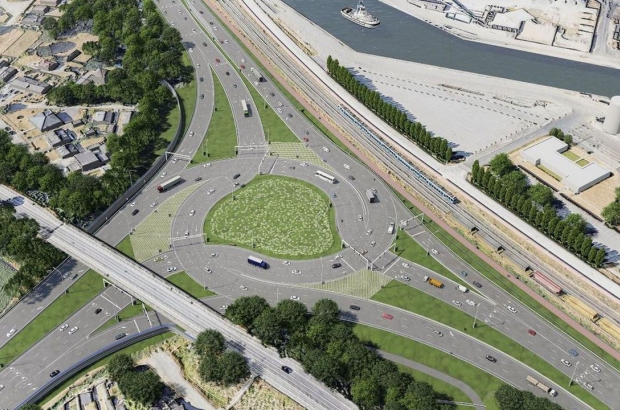- Daily & Weekly newsletters
- Buy & download The Bulletin
- Comment on our articles
Belgium's first 'turbo traffic square' confuses motorists
The first so-called turbo traffic square in Belgium has been opened on the R4 around Ghent, VRT News reports. Its construction and implantation into the road system has led to questions, the most popular being ‘what is a turbo traffic square?’
Viewed from the air, at first glance, it is indeed a bizarre spectacle. Unlike at a classic intersection, traffic that wants to go to the left has to make a large turn onto a three-lane road and occasionally wait for traffic lights. It looks like a roundabout, but it's not strictly one because you can't really drive in circles. So why did the government choose such a design?
"A first solution was to redesign and renovate the existing intersection, but then you still have traffic jams,” says Marijn Struyf of De Werkvennootschap, the organisation that's renovating the Ghent ring road on behalf of the Flemish government. “A classic roundabout would have led to even longer traffic jams. That's why we have opted for a turbo traffic square that can handle up to 25% more traffic than the traffic that is already there today. It is a solution that works well in terms of traffic flow."
The turbo square is based on the design of the already well-known turbo roundabout. To enter the roundabout, you have to choose the right pre-sorting lane or lanes, instead of changing directions at the roundabout. This is also the case with a turbo square.
A turbo square is usually built where an ordinary turbo roundabout no longer works because it is too busy. These are often intersections with roads of two lanes or more. Theoretically, a turbo square can handle 11,000 motor vehicles per hour. At an ordinary intersection there are about 8,000 in the same circumstances.
An ordinary turbo roundabout works like a turbo traffic square, but with the difference that you can drive full circles there. The traffic that wants to go to the right (quarter turn) must pre-sort in advance. Traffic that has to cross the roundabout (straight ahead or three-quarters of a turn) sorts left in front. This way you get a better flow and on the roundabout itself there is also less confusion because you no longer have to change lanes.
A turbo square ensures lower driving speeds on the square which positively influences traffic safety compared to intersections with traffic lights.
To strengthen the positive effect of a turbo square, clear signage is needed at least 400 metres before the choice of lane needs to be made.
Dutch research by the renowned TNO Delft shows that drivers have to wait an average of 45 seconds less for the red light at a turbo square. This is on condition that there are enough detectors in the road to measure traffic. Currently, Flanders does not apply these Dutch standards (with four detectors per direction).
The same Dutch research shows that many people find a turbo traffic square complex. However, once you've passed it a few times, it makes sense: road users appreciate the better traffic flow. For one-off passers-by, it is a challenge.
TNO even recommends to "be cautious in applying this type of intersection form and to consider the application only if the traffic capacity for heavy crossing traffic flows really makes it necessary."
As far as the safety of cyclists is concerned, it is clear on a turbo square that they need separate paths and preferably also tunnels under lanes for cars. This is the case with the one in Ghent.


















